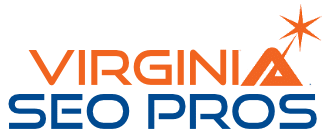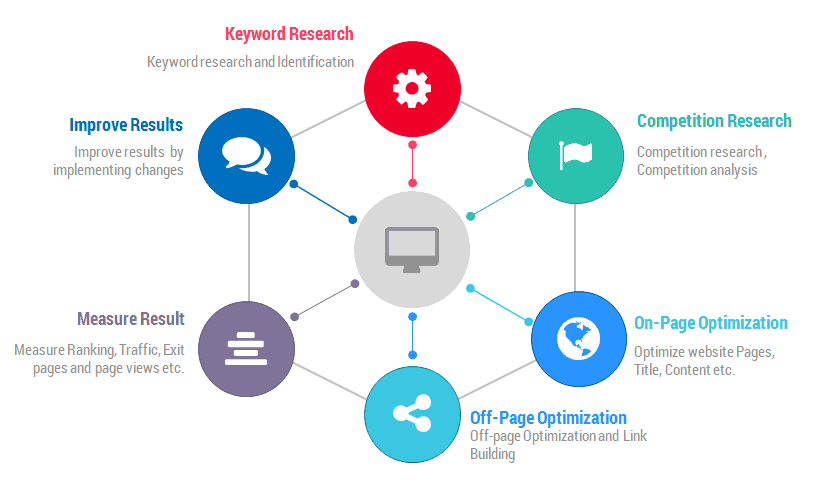When contemplating a search engine optimization (SEO) project, it’s important to understand the process involved in an effective SEO campaign. To that end, we break down the process into the six steps shown below and describe the actions involved in each of these measures.
1. SEO does not begin and finish with these measures and the first work that we do. In order to have continuing success, it’s necessary to track results and construct meaningful content on a continual basis. I once read the perfect description of the SEO process (by John Tawadros), “it [search engine optimization] is inherently iterative. In short, it is a process, not a project.”
Keyword Research
Keyword phrase research involves identifying a group of keyword phrases which are used in optimization. This step is critical and requires a considerable amount of time to find a good set of phrases offering a balanced blend of two important factors: high usage by searchers and comparatively low competition within the search engines.
Determining the most used phrase that has your targeted keyword(s) is relatively straightforward. Online tools permit you to enter a specific keyword or words and will return all the ways in which that phrase(s) was used by searchers in the last month and in what quantity. However, the most used phrase(s) is also likely the one with the greatest competition in the search results and may, therefore, not be where you’d want to dedicate your optimization efforts. A more effective approach is to discover a set of phrases (10 is a nice round number) which are heavily used by searchers but somewhat less competitive concerning the total number of search results.
For instance, assume you have a business that leases apartments in a specific metropolitan area, “Big City.” Your apartments are only located in one metro area, so you are not likely to select general terms such as “apartments;” you’re only interested in those searchers looking for an apartment in town. The logical place to begin is using the name of your town as well as the term “apartments.” You may find that the most used phrase is “big city apartments.” However, if you do sample searches in Google and Yahoo for that term you realize that the competition for that term is steep. If you return to your findings from the keyword tool, you might discover that a phrase such as “flats in the big city” remains heavily used by searchers, however, is much less competitive. These phrases are the ones you will then target in the next step, website optimization.
We use a collection of SEO metrics, such as indexed content, Alexa rating, inbound links, domain age, and social networking after among others. Through this procedure, we have the ability to estimate the customer website’s starting position against its competition and identify areas requiring priority in the following work. By way of example, if we see that relative to the contest, the client’s site has 50% less indexed content, then content construction would be a priority at the goal setting that happens in the next period.
After establishing your targeted keyword phrases and beginning position relative to the site’s competitive set, it’s important to understand what the subject site’s starting position is within the search engines. Doing this ensures that you know the specific areas that require work and provides a baseline against which to gauge the subsequent campaign’s success.
Access to website traffic information is very important. These numbers show how searchers are discovering and interacting with the subject website, e.g., which search engines, what keyword phrases are being used, bounce rates, hottest content, etc.. Understanding the website’s traffic level and the source of its referrals can also be a vital tool in making other online marketing decisions.
After developing a comprehensive picture of the site’s starting position, goals are set for the SEO plan. These goals are measurable (one big advantages of SEO over other advertising options) and tied to the specific business objectives of the site. In the continuing progress of reporting and follow up, progress towards the plan’s goals is examined and reported. Adjustments to the SEO plan can be made based on the findings of these reports.
Content Building
Content is king in search engine optimization. The search engines love text; large volume, high-quality content related to your business will serve you in a couple of important ways.
After all, the reason they came to your website was to locate information. Second, you will get the extra benefit of serving up exactly what the search engines want — articles. Search engines will have more information to store about your business and products; that info will translate directly into the ranking they give your site for related keyword phrases. To find out more on content creation and specific ideas about ways to enlarge your site’s content, read our, Content is Still King.
We often find at the Competitive Research phase the client’s website is falling behind its competitors in the amount of content that is indexed. In those cases, this phase of the method takes on additional significance.

Page Optimization
Following the addition of new, high-quality articles, we tackle on-page optimization. See our piece on Page Optimization Basics to find out more on this topic.
Page Titles — Make sure that your site’s page titles say something besides just your company name or “welcome.” Ideally, they need to lead off with your targeted phrase for that page and then follow your organization name.
Text-Based Navigation — Search engines can’t read images. If your site’s navigation system is completed with pictures (lots are), you’ll need a text-based navigation system which the search engines may follow to ensure that all of the important service and product-related sub-pages of your website are indexed by the search engines.
The prominence of Targeted Keyword Phrases — It isn’t enough to have your keyword term(s) somewhere on the web page, the positioning and prominence gave to them also affect your search engine placement. Also, using larger font sizes and bolding the text can emphasize its importance and positively alter the page’s ranking for that phrase.
Site Map — Developing a sitemap that includes a well-organized list of links to all the important pages of your website and includes a text link to the sitemap on your home page is the ideal way to make sure that all the site’s pages are indexed by the search engines when they visit the subject site. Google’s Webmaster Tools is ideal for this purpose.
ALT and META data — These are tags not seen by the site’s users; they are embedded in the site’s code. ALT tags refer to the text that describes the image — words that you see pop up as you mouse over some pictures. In optimizing your business’s name, an ALT tag positioned behind the image of your company’s logo is ideal. Meta tags are lines of code included in the uppermost part of your site’s code. Further, the short description of your site included in some search results is pulled from the meta description tag of the home page and should, therefore, be used to the site’s advantage.

Get real help now with Your SEO Now,
call us at 1-833-GET-SEO1 or via email.
Clean up the Code — Navigation rollover scripts, other JavaScript-based code, and all CSS scripts should be taken out of the code of each page and place into external files to which each page of the site is referenced. Doing this has several advantages but among the most compelling is that your site’s keywords and content all move up, up, up in the code, communicating their importance to the search engines and boosting your site’s relevancy ratings. To put it differently, this can boost your search engine positions by improving the code to text ratio of the webpage. This is a simple and relatively inexpensive thing to do, based on the total number of pages in your website.
Social & Link Building
Social Media
And, the fish are using social networking in increasing numbers. The power of internet sharing through social media provides enormous opportunities for companies ready to devote the time to use it. During this phase of the process, we help clients establish a social media presence and consult with the client on how best to use those social networking profiles to discuss website content and connect with clients and prospective customers.
Construction In-Bound Links
Each new, quality connection to your site increases the likelihood of the search engines’ spiders running across your site in addition to searchers looking for services or products like yours. Google perspectives links to your website (as long as they are hyperlinks from high-quality sites) as votes for your website and rewards the site accordingly. You can check your link popularity with various free online tools. In addition, Google’s Webmaster Tools provides information regarding the inbound links to your website. A word of warning: free for all links sites and other low carb sites of that nature are of no use and, in fact, detract from your advancement with penalties from the search engines. This became even more important with Google’s release of the Penguin algorithm update. We consult with our customers on ways to construct their online reach and influence with fresh, high-quality inbound links.
The identical reporting done in the first phase of the effort is done again at regular intervals, post-optimization. Rankings, website traffic levels, social signals and other key metrics can then be compared to pre-optimization amounts, providing measurable results to the SEO campaign. The specific metrics used within an SEO plan will be based on the goals of the site.
IMPORTANT NOTES:
Time Frame
It can take a while for the search engines to index a site and the rankings to change to that site. For some search engines, the lag time between the work and viewing results can be as long as six months. Clients need to be patient and have realistic expectations concerning the time period involved with organic (the organic, non-paid results) search engine positions. If the company need for greater search engine prominence is greater than can be met with optimization alone, I suggest including a pay-per-click (PPC) campaign to the marketing mix to bridge the time. PPC campaigns such as Google’s AdWords can be installed in a matter of days, allowing for instant results.
Rankings Guarantees
We can’t guarantee any specific rankings for specific phrases. There’s absolutely no way to guarantee a particular placement within the organic search results of any search engine. Spark factory optimizes a website so that it is as attractive as possible to the search engines, using only white hat tactics. Specifically, Spark factory’s recommendations would ensure that the site is easily spiderable, loaded with keyword-rich content, appreciates quality inbound links, provides a great user experience, and is analyzed and refined based on its performance against our stated goals. These are methods that have proven over time to successful SEO strategies for our clients.
Be very cautious about any SEO company that promises specific positions.
The SEO work we perform includes minor non-substantive changes to the site’s existing content/text, highlighting the targeted keyword phrases. We make recommendations on new content; the writing of any new substantive content is the responsibility of the client. We are happy to connect you with terrific copywriters if composing the new content isn’t readily done within your organization. We then take your words and make our non-substantive changes to it, to be able to maximize its effectiveness. If you don’t want us to make these minor changes to your website’s text, please let us know.

Get real help now with Your SEO Now,
call us at 1-833-GET-SEO1 or via email.


